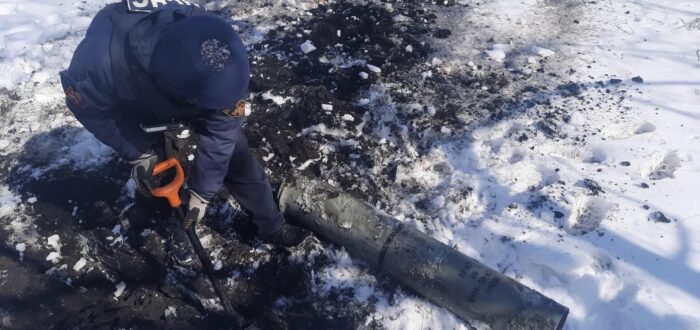N.R. Jenzen-Jones & Patrick Senft
Editor’s Note: This article is based primarily on previous ARES articles documenting the use of the N235 submunition in Ukraine in 2022 and 2014, and the 9M27K cargo rocket in Ukraine in 2014.
A number of submunitions resembling the Soviet/Russian 9N210 and 9N235 models have been documented during the course of the most recent Russian invasion of Ukraine. Due to their near-identical external appearance, these two submunitions can be difficult to distinguish without a close visual inspection. The 9N235 has previously been positively identified by ARES. In examining media from a recent strike in Kharkiv, ARES has now been able to positively identify the use of 9N210 submunitions by Russian forces in Ukraine. Images shared by the State Emergency Service of Ukraine (DSNS) show a cargo rocket that failed to function as intended, and did not dispense its submunitions (see Figure 1). Therocket is clearly marked in Cyrillic with “9H210” (‘9N210’), indicating the designation of the submunition it carries. Further markings indicate the designation of the carrier munition itself—a 9M27K cargo rocket—as well as the year of production (1987) and lot/batch information that may be helpful in future analysis.

The 9N210 submunition is a high explosive fragmentation (HE-FRAG) submunition designed to engage both personnel and unarmoured vehicles in open terrain or behind light cover. The body of the 9N210 is cylindrical in form, measuring 263 mm in length and 65 mm in diameter. Each 9N210 features six spring-loaded fins, which open after separation from the carrier munition to orient the submunition such that its impact fuze fitted in its nose strikes the ground first. The 9N210 is fitted with either the 9E246 or 9E246M fuze. The 9E246M fuze features a self-destruct mechanism that is designed to function 60 seconds after the submunition’s ejection from the cargo rocket. The 9E246 does not feature a self-destruct mechanism. 9N210 submunitions contain 300 g of what is believed to be A-IX-10 explosive composition, consisting of 95% RDX phlegmatised by the addition of 5% paraffin wax.

While externally nearly identical, the 9N210 differs from the 9N235 primarily in the number and size of the pre-formed fragmentation it contains. The 9N210 contains 370 to 400 pre-formed fragments of chopped steel, each weighing a nominal 2 g, whereas the 9N235 contains pre-formed fragments of two sizes: the smaller fragments (nominally weighing 0.75 g) are mainly intended to injure and kill personnel, whereas the larger fragments (nominally 4.5 g) are intended to damage lightly armoured vehicles and materiel. Each 9N235 contains approximately 96 4.5 g fragments and 360 0.75 g fragments. In both designs, the pre-formed fragmentation is held by a polymer matrix which surrounds the main explosive charge of the submunition. Both the fragments themselves and, on occasion, the matrix in which they are held are recovered from impact sites or partially detonated munitions. It is possible to differentiate 9N235 and 9N210 submunitions from partial munition remnants and pre-formed fragments.

As noted, the markings on the munition documented in Kharkiv allow for its positive identification as a 9M27K cargo rocket. The 220 mm 9M27K rocket is fired by the 9K57 Uragan (Ураган; ‘Hurricane’) multiple-barrel rocket launcher (MBRL). When the cargo rocket carries the 9N210 fragmentation submunitions, it has a range of between 10 to 35 km and can deliver 30 submunitions. The rocket weighs 270 kg (90 kg of which is the warhead) and measures 5,178 mm in length. The 9N210 can also be delivered by the 300 mm 9M55K cargo rocket fired by the 9K58 Smerch (Смерч; ‘Tornado’) MBRL. Whilst both the 220 mm and 300 mm munitions can deliver both 9N210 and 9N235 submunitions, the 9N210 is most often associated with the Uragan, whilst the 9N235 is most often associated with the Smerch. ARES has previously documented 9N235 submunitions delivered by the Smerch MBRL during the most recent Russian invasion of Ukraine. The 9M55K and 9M27K cargo rockets are depicted in Figure 4.

Technical Characteristics
9N210 submunition
Length: 263 mm
Diameter: 65 mm
Weight: 1.80 kg
Explosive weight: 300 g
Explosive composition: A-IX-10
Number of pre-formed fragments: 370 to 400 x 2 g.
Fuze: 9E246 or 9E246M
9M27K cargo rocket (with 9N210 submunitions)
Range: 10–35 km
Weight: 270 kg
Length: 5,178 mm
Warhead weight: 90 kg
Payload: 30 × 9N210 submunitions
Special thanks to Tony Salvo. Header image source: DSNS via ARES CONMAT Database.

Sources
ARES (Armament Research Services). n.d. Conflict Materiel (CONMAT) Database. Confidential. Perth: ARES.
Jenzen-Jones, N.R. 2014a. ‘9M55K cargo rockets and 9N235 submunitions in Ukraine’. The Hoplite. 3 July. <http://armamentresearch.com/9m55k-cargo-rockets-and-9n235-submunitions-in-ukraine/>.
Jenzen-Jones, N.R. 2014b. ‘9M27K series cargo rockets used in Ukraine’. The Hoplite. 11 July. <http://armamentresearch.com/9m27k-series-cargo-rockets-used-in-ukraine/>.
Jenzen-Jones, N.R. & Yuri Lyamin. 2014. ‘9M55K Cargo Rockets and 9N235 Submunitions in Syria’. The Hoplite. 16 February. <http://armamentresearch.com/9m55k-cargo-rockets-and-9n235-submunitions-in-syria/>.
Lyamin, Yuri & Michael Smallwood. ‘9M27K Series Cargo Rockets in Syria’. The Hoplite. 22 February. <http://armamentresearch.com/9m27k-series-cargo-rockets-in-syria/>.
Salem, Harriet. 2014. ”I Couldn’t Move for Five Minutes from Fear’: An Investigation Into Cluster Bombs in Eastern Ukraine’. VICE News. 22 October. <https://www.vice.com/en/article/8x733a/i-couldnt-move-for-five-minutes-from-fear-an-investigation-into-cluster-bombs-in-eastern-ukraine>.
Jenzen-Jones, N.R. & Patrick Senft. 2022. ‘Russian 9N235 submunitions documented in Ukraine (2022)’. The Hoblite. 13 March 2022. < http://armamentresearch.com/russian-9n235-submunitions-documented-in-ukraine-2022/>.
U.S. Army. 2009. Handbook of Ammunition for Afghanistan and Surrounding Area. Revision 9 (January 2009). Picatinny Arsenal: ARDEC EOD Technology Directorate, Foreign Ordnance Team.
Remember, all arms and munitions are dangerous. Treat all firearms as if they are loaded, and all munitions as if they are live, until you have personally confirmed otherwise. If you do not have specialist knowledge, never assume that arms or munitions are safe to handle until they have been inspected by a subject matter specialist. You should not approach, handle, move, operate, or modify arms and munitions unless explicitly trained to do so. If you encounter any unexploded ordnance (UXO) or explosive remnants of war (ERW), always remember the ‘ARMS’ acronym:
AVOID the area
RECORD all relevant information
MARK the area from a safe distance to warn others
SEEK assistance from the relevant authorities

